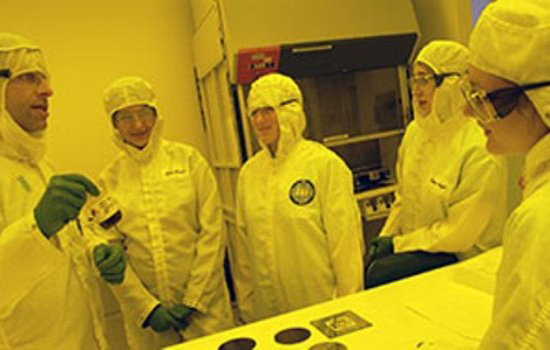‘Micro-e’ program hits quarter-century mark
Microelectronics growth sparked PC revolution 25 years ago
A. Sue Weisler
As one of the strong ties between RIT and the Town of Henrietta, students from the Rush-Henrietta Central School District regularly visit RIT microelectronic engineering labs—just as a different group of youngsters recently toured RIT’s Semiconductor & Microsystems Fabrication Laboratory. Gowns are required to protect microchips from contamination, and yellow light (resulting from filtering short wavelengths from white light) is used to avoid exposure of the photoresist during microchip processing. RIT’s Department of Microelectronic Engineering is celebrating its 25th anniversary this year.
Communication. Virtual commerce. Healthcare breakthroughs. Entertainment. Access to a base of knowledge accumulated from the start of time. All any time, any place . . . and attributed to advances in the semiconductor industry. For more than a quarter century, RIT has contributed to this microelectronic engineering revolution. The university’s microelectronic engineering program—the first of its kind in the nation—launched Jan. 20, 1982.
At the time, President Ronald Reagan was beginning the second year of his first term, America’s first “test tube” baby was about three weeks old, AT&T had just agreed to a breakup, Dallas was the nation’s most popular television show, and Olivia Newton-John’s Physical was climbing Billboard’s “Hot 100” chart. About five months earlier, in August 1981, IBM Corp. introduced the first IBM personal computer featuring 16 KB of random-access memory, or RAM, and an operating speed of 4.77 MHz. It retailed for about $1,200. Today, some PCs have 2 GB of RAM, run at 3 GHz and sell for less than half the price of that first home computer.
Similarly, RIT’s “micro-e” department has grown by leaps and bounds in its technological capabilities since the early ’80s. Today’s 150 undergraduate and graduate students are instructed by eight faculty members in space that includes the 10,000-square-foot Semiconductor & Microsystems Fabrication Laboratory—the largest “clean room” dedicated to education in the country.
This week, the department celebrated its silver anniversary and the hosting of its 25th annual conference with an anniversary dinner at the Hyatt Regency Rochester. Micro-e’s impact felt nationally . . . More than 600 RIT micro-e graduates currently work in the semiconductor field, with a huge majority of them—roughly 90 percent—employed in the United States, says Santosh Kurinec, professor and department head. The homegrown talent represents a significant contribution to American society and the world, she asserts. “We’re grooming a domestic workforce to meet the demands of this global high-tech industry,” says Kurinec, who, as department head since 2001, is one of only two people to have held the position.
Lynn Fuller, RIT professor of microelectronic engineering, was the founding department head. Among the 600 grads, more than 100 are currently employed by Freescale Inc. (formerly part of Motorola Inc.), about 80 work for Intel Corp., some 60 earn paychecks from IBM, and more than 60 have gone on to graduate school. Other top employers of RIT micro-e grads include National Semiconductor Corp., Advanced Micro Devices Inc. and Micron Technology Inc. . . . and locally Though the RIT micro-e program’s influence is spread worldwide, its impact is felt nowhere stronger than right here in Henrietta.
Three Henrietta-based companies have had direct ties to RIT’s micro-e program: Amphibian Systems, located on Tech Park Drive, was founded by Bruce Smith, Intel Professor of Microelectronic Engineering; and Integrated Nano-Technologies, on Lehigh Station Road, and Advanced Vision Technologies Inc., formerly on Lucius Gordon Drive, collaborated with RIT micro-e faculty. Additionally, three current members of the RIT micro-e faculty—Smith, Karl Hirschman and Rob Pearson—are graduates of the Rush-Henrietta Central School District and RIT. Another Rush-Henrietta and RIT micro-e grad, Steve Carlson, was named an RIT Outstanding Alumnus in 1999. Because of the strong ties between RIT’s micro-e department and its hometown, the Henrietta Chamber of Commerce on May 9 presented a 2007 Community of Excellence Award to the department. Kurinec points out that students, recruiters, vendors, short-course attendees (typically adult students completing short, intensive training sessions paid for by their employers) and other visitors all boost the town’s economy. “In placing Rochester on the map educationally, micro-e also brings hundreds of people yearly to Henrietta hotels and restaurants,” she says.
Toward the future Along with a B.S. in microelectronic engineering, RIT students can now earn an M.E. in microelectronics manufacturing engineering (which is also offered online, attracting students nationally and internationally), an M.S. in microelectronic engineering, a B.S./M.S. in microelectronics/ materials science and engineering, and a Ph.D. in microsystems engineering—a first-of-its kind multidisciplinary doctoral degree launched in 2002. In 2005, the department created a minor in microelectronics and nanofabrication.
To further illustrate from where the field of microelectronic engineering has come in 25 years, Kurinec says: “In 1982, the smallest feature printed in a microchip was one hundredth (1/100) the diameter of a typical human hair. Today, it’s about 0.5 thousandths (1/2000) the diameter of a human hair. The thin insulating film in modern transistors is a few molecules thick. These extreme dimensions are produced with accuracy and reproducibility everyday. These are the marvels of today’s semiconductor technology.” As for the next quarter century in microelectronic engineering, Kurinec predicts: “The next 25 years will see further miniaturization of the microchip using nanotechnology, and the convergence of many technologies such as nanoelectronics, nano-mechanics, photonics, bio and novel computing, and software developments. Every person will have easy access to the accumulated knowledge of the human race at any time and in any place, format and language. We may have voice recognition with wireless access in our PC devices, which may be wearable and have terahertz speeds and terabyte memories. We’ll see the PC interacting with sensing and biological interfaces.”
RIT micro-e by the numbers Age: 25 years (Jan. 20, 1982) Department heads in 25 years: 2 Graduates working in the semi-conductor field: 600 Most grads employed by a single company: 110 (Freescale Inc.) Undergraduate enrollment: 110 Graduate enrollment: 40 Faculty: 8 Faculty who are graduates of both Rush-Henrietta schools and RIT: 3 Henrietta companies founded by a faculty member: 1 (Amphibian Systems) Degrees offered: 5 (B.S., M.E., M.S., B.S./M.S., Ph.D.) Square footage of Semiconductor & Microsystems Fabrication Laboratory: 10,000 (largest “clean room” dedicated to education in the country)















